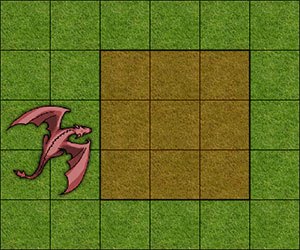The differences between blasts and bursts were something that we struggled to wrap our heads around at first, so I made a few images and descriptions for us to use as quick references. Hopefully others might benefit from them too.
A blast is what you might imagine when a dragon breathes fire. It must originate from a square within the users space and the blast area must occupy at least one adjacent square to its origin. The area that the blast fills is always a square, the width of which is specified by each power. For example, a blast 2 fills a 2-square-by-2-square area. A blast only affects targets in its area if there is line of effect from the origin square to the target. Blasts do not provoke opportunity attacks.

Blast 2 by a medium sized user.

Blast 3 by a large sized user.
There are two types of burst attack; close burst is what you might imagine if an enemy swung a flail 360 degrees, area burst is what you might imagine if an enemy threw a barrel of oil that exploded as it smashed on the floor.
Close bursts extend outwards in every direction from the user. The distance that the close burst extends is specified by each power. For example, a close burst 2 extends 2 squares in every direction from the user. The actual size of the area varies depending on the size category of the user. For a medium sized user that occupies a single square, a close burst 2 would actually fill a 5-square-by-5-square area with the medium user in the center square. A large sized user occupies a 2-square-by-2-square area, so a close burst 2 would actually fill a 6-square-by-6-square area with the large user in the center squares. A close burst only affects targets within its area if there is line of effect from the user to the target. Close bursts do not provoke opportunity attacks and the user is not affected by their own close burst, unless the power states otherwise.

Close burst 2 by a medium sized user.

Close burst 1 by a large sized user.
Area bursts can originate from a square up to a range from the user. The burst then extends outwards from the target square in every direction. The range and burst distance are specified by each power. For example, a burst 2 within 10 squares means that the burst can be placed up to 10 squares away from the user and the burst would then affect its origin square and every square within 2 squares of it. An area burst can provoke opportunity attacks and unless the power states otherwise, an area burst can affect the user.

Area burst 1, within 5 squares. Note that the origin square is also affected.

Area burst 2, within 5 squares. Note that the burst can be placed anywhere up to 5 squares, it doesn't need to be maximum range. The user can also be affected by the burst.
So if anyone wants to try D&D 4th Edition but is worried about learning the rules, don't be! You won't be alone in not knowing or misunderstanding some rules and you certainly don't need to know every rule from the very beginning (or even use them all, when you do know them). Start playing and having fun, your knowledge of the game will develop naturally.
Thanks for covering this. My friends and I have been debating this for quite awhile now!
ReplyDeleteExcelent explanation of this two concepts. Greetings from Argentina!
ReplyDeleteI like the pictures, now i won't have a problem with it ever again
ReplyDeleteLike many explanations including WoTC's own this one is an epic fail for not describing the third dimension.
ReplyDeleteThank you very much!!
ReplyDeleteWhat is the official reference for the article's claim that close attacks (blasts and bursts) do not provoke? Every official reference that I can find, from the PHB to the Compendium on Wizards' website, says that "ranged attacks and area attacks" provoke. I can't find any exception for close attacks, and the fact that area attacks and ranged attacks are separated seems to indicate that an area attack provokes even if it is not ranged.
ReplyDeleteAh, I think I see it.
ReplyDeleteThere is no explicit exception for this, but there seems to be an implicit one. The reason is that the 4E rules use a very narrow definition of "area power" that does not include close powers - even if the powers produce an area of effect.
This is a bit odd, but I see it in the Rules Compendium (the hardcopy version, pages 101 to 105). This section describes Ranged, Close, and Area powers in three separate entries (even though it stipulates that close powers often affect an area). It specifies that Ranged and Area powers provoke, but it doesn't say that Close powers do.
This is poor writing, IMO (as a technical writer), and decidedly non-intuitive. An "area power" logically ought to be any power that produces an area of effect. However it's clear enough once one digs into the rules and sees the three types described side by side. A Close power is not an Area power, even if it affects an area, and Close powers are not described as provoking.
When it says "Area attacks provoke opportunity attacks," it refers strictly to powers with the AREA keyword. Maybe I'm wrong but, I think this is what is meant - remember your keywords! If this were not the case, close burst 1 would be THE WORST thing in the world, because it would also provoke opportunity attacks from every single creature you can hit yourself. Ouch!
ReplyDeleteThank you! This was perfect!
ReplyDeleteThank you so much for this. I turned them into a printable sheet for quick reference :)
ReplyDelete